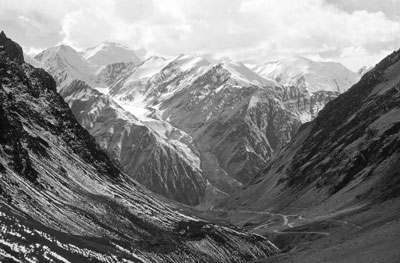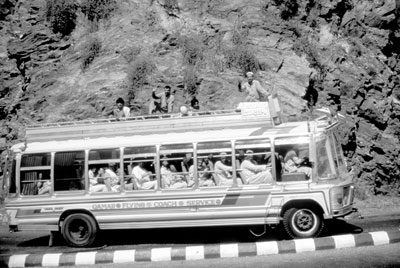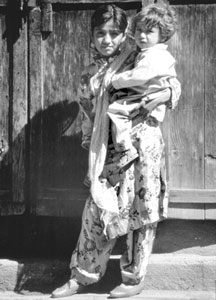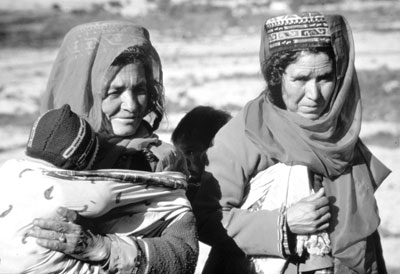Pakistan’s earthquake-prone Shangri-la
by Ed Kinney
My wife, Moreen, and I were not surprised, though we were dismayed, by the destruction and loss of life caused by the massive earthquake that struck northern Pakistan in October 2005. It’s difficult for anyone who has never visited this area of 25,000-foot mountains to fully comprehend what occurred.
Granted, media reports and photographs help. Unfortunately, most view this area as the hideout of notorious Osama bin Laden or possibly as what is described in James Hilton’s fictional novel “Lost Horizon.” In the story, people lived to be 100 in valleys carved by glaciers born in magnificent mountains. In actuality, life is very difficult in these Himalayas, making many people appear to be 100!
Years before bin Laden and the Taliban and al Qa’ida set up camp in northern Pakistan, we spent a week with a now-defunct travel company (Hemphill-Harris), driving the Karakoram Highway from Peshawar to the Khunjerab Pass, which connects Pakistan with China. This road, paralleling the ancient Silk Road, required 20 years to build plus, reportedly, a thousand Chinese and Pakistani lives.
Leaving Peshawar, Pakistan, the macadam road begins smoothly but soon becomes convoluted, requiring tricky maneuvers around cliffs and over rock slides thousands of feet above the Indus River and, farther along, the Hunza River. In some sections, the highway is little more than a narrow ledge blasted with dynamite out of sheer rock. Nature may have been tamed here but certainly not conquered.
The Indus River flows over a chasm separating the Asian land mass from the tectonic plate of the Indian subcontinent. Earth tremors occur here every three minutes (most are not detectable without instruments), and the Indian plate is moving northward rapidly, at two inches a year. Quakes and changing weather constantly affect the Karakoram Highway as it maneuvers ever higher through the youngest and highest mountains in the world.
It’s not unusual here to be greeted by a loud explosion and a cloud of dust while inching around a sheer cliff. Pakistanis will be blasting away a recent slide, preventing convoys of trucks from proceeding to and from China. Drivers then confidently bounce over this newly repaired section of road high above the Indus River. Our vehicle would shake, rattle and roll over these repairs.
Pakistani truckers consider these “repairs” as annoyances, not obstacles. We frequently saw signs saying, “Relax, Slide Area Ends, Have A Nice Drive.” Pakistani humor?
Swat Valley area
While visiting the Swat Valley, for two nights we stayed in the Swat Serena Hotel in Saidu Sherif. Built in 1940 as a guest house for the adjacent governor’s home, this hotel was a relic from the British rule of Pakistan. Our large room was cooled by ceiling fans, and a wood-burning stove heated our shower water. Later accommodations were not as good.
Alexander the Great in 327 B.C. and subsequent armies routinely marched through the beautiful Swat Valley, long renowned for its scenic beauty, with green terraced hills and flowing rivers. Northern Pakistanis, agrarians, coax and nurture the soil, little changed by time.
Merchants in small village bazaars studied us politely, waiting to be asked, “How much?” In the village of Bahrain we saw a young Pakistani girl, maybe seven years old, carrying her much younger brother. She never changed expression when I gave her a ballpoint pen for posing for my camera. Young Muslim girls had enigmatic faces with sad eyes that seldom showed emotion — so young yet so mature, knowing early on the hardships they’ll endure for life.
The mountain village of Karimabad
To reach Karimabad, the old capital of Hunza located high above the Karakorum Highway, we switched from a 10-passenger van into WWII jeeps. Then we dearly hung on while young village men navigated the steep, rutted dirt roads between mudstone homes and rock fences that separated rows of apricot trees.
Locals utilize apricots to the fullest, eating them fresh or, in the winter, dried and preserving them for jam. The pits are pounded for oil or ground into flour, with the remainder fed to livestock. Maybe apricots are a secret potion for longevity!
Hunza was an ancient monarchy until it became part of Pakistan in 1974. Life has remained simple there, even following the opening of the Karakoram Highway in 1982.
Followers of the now-deceased Aga Khan, Hunzakuts are members of a relatively progressive sect of Islam which provides them money for schools and health care. Many of the locals are fair skinned with blue eyes, possibly credited to Alexander the Great’s soldiers.
The highlight of our visit here was viewing the Altit Fort, one tower of which was built in 1503, and later hiking up to the more impressive 14th-century-A.D. Baltit Fort, restored in the 19th century. This fort stands like a solitary soldier with its commanding view of the Hunza Valley.
Roof of the world
During our drive on the Karakoram Highway, we passed through the towering shadows of 26,600-foot Nanga Parbat and 25,551-foot Mount Rakaposhi. Then it was our turn to drive an additional 8,000 feet higher to the summit of the Karakorum Highway, the 15,380-foot Khunjerab Pass which joins Pakistan and China.
After having our passports inspected in the small village of Bili (though we were not “officially” entering China), we began a series of switchbacks, climbing higher until there appeared a broad flat plateau covered with patches of snow. China stood before us, marked only by a red concrete block noting its border with Pakistan.
Initially, we were the only ones there, except for a lone Pakistani soldier with an ancient rifle. Later, a small group of Chinese delegates appeared. Except for giving a slight nod, they too ignored us while enjoying, as we did, this once-in-a-lifetime experience of standing at the top of the world. At that point, I understood the passion of mountain climbers.
Parting thought
As Marcel Proust (1871-1922) wrote, “We don’t receive wisdom; we must discover it for ourselves after a journey that no one can take for us to spare us.”
Though Moreen and I have traveled in northern Pakistan, meeting its people and observing their mudstone homes, we can only partially appreciate the horrific damage inflicted by last fall’s earthquake and the suffering these people went through and are now experiencing. Shangri-la is beautiful fiction.
Minutiae
The State Department has a travel warning posted regarding Pakistan. For details, call 202/647-5225 or visit http://travel.state.gov.
Those seeking information regarding Pakistan may wish to contact the Embassy of Pakistan, 517 International Ct. NW, Washington, D.C., 20008; phone 202/243-6500 or visit http://www.embassyofpakistanusa.org.
The motels we experienced were possibly 2-star, having twin beds with a bathroom and shower. The farther north we traveled toward China, the more intermittent the electric power was. (Showering by candlelight is interesting.) Local food was okay, though often it was cooked in considerable amounts of cooking oil and highly seasoned with chili peppers. From what I can glean on the Internet, travel accommodations have improved since our visit.
Coming up — let’s visit Tunisia’s wonderful Dougga and Bulla Regia ruins.





